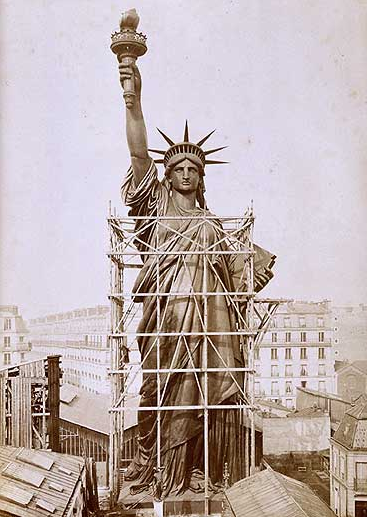When it comes to great American icons, none can hold a candle (or a torch) to Lady Liberty. Originally called “Liberty Enlightening the World,” she is universally recognized as a symbol of freedom and democracy and was the first sight that greeted millions of immigrants arriving by boat during the second half of the 19th century. Chances are, if you’ve ever been to the Big Apple, you made a point of visiting her.
Fun facts:
- She stands 305 feet, 6 inches tall from the pedestal base to the tip of her torch.
- In strong winds (50 mph), the statue can sway up to 3 inches, and the torch up to 6 inches.
- Oxidization turned her 31 tons of copper skin green (just like a penny when you leave it in water).
- Construction of the pedestal was groundbreaking and involved the largest concrete pour ever made (at the time).
You probably know the statue was designed and constructed in Paris before being disassembled and shipped across the ocean. But did you know that it was 1 of the earliest examples of curtain wall construction? French civil engineer and architect Gustave Eiffel designed and created the inner framework, an iron skeleton that supports the copper curtain wall “skin.” (French artist Frédéric-Auguste Bartholdi designed the statue itself.) Eiffel used this project as a proving ground for his later work designing and constructing his famous Parisian namesake.
Though widely used now, the curtain wall technique was revolutionary at the time and was copied in 1885 for the construction of the first skyscraper, the 10-story Home Insurance Building in Chicago. Curtain wall systems transfer loads to the inner structure and allow the use of lightweight materials for outer walls, which need only keep the weather out and the occupants in. This reduces construction costs and enables the building of taller structures. (But you already knew that, didn’t you?) Before the advent of curtain walls, buildings relied on load-bearing exterior walls, which meant they had to be made from heavy materials (typically stone) in order to support the entire structure.
If you’re a Revit user, check out this great class with BIM expert Matthew Stachoni and learn about building efficient curtain wall panels, profiles, and mullion family types for a variety of construction uses:
Revit Master Class: Building Construction-Ready Curtain Walls
Let freedom (to build taller structures at lower cost with high performance and less maintenance) reign.






(0)